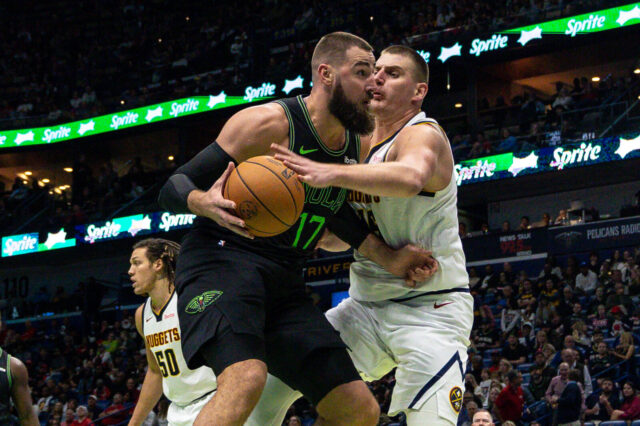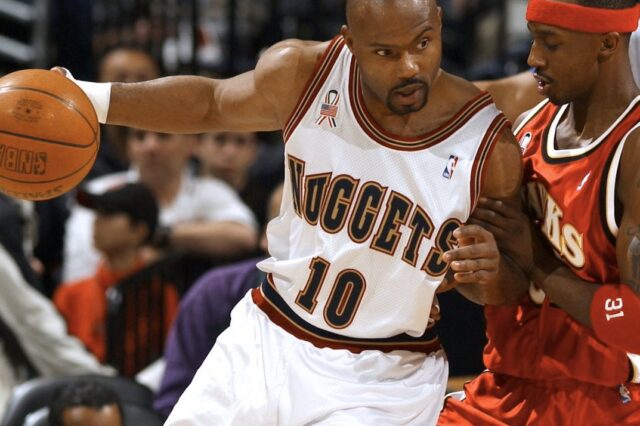It’s game time!
I mean…it’s Mailbag time!
Let’s take a look at the efficiency numbers for Gary Harris.
His career high in field goal percentage occurred in 2016-17 when he shot 50.2% from the field. This is considered the best offensive year for the Nuggets and the most purely “Jokic-ball” year. Back cuts were commonplace, the floor was spaced very well, and Nikola Jokic developed excellent chemistry with Harris to help generate easy shots at the rim.
Harris is a more skilled player now than he was in 2016-17, but what made him extremely efficient that year was his shot distribution. Like I have discussed with Jamal Murray in the past, Harris has trended toward more inefficient shots in the mid range in recent seasons.
This content is no longer available.
Harris is an interesting case due to his changing role within Denver’s system. During the 2016-17 season, Harris was merely a cog in the wheel and performed well as a floor spacer, cutter, and transition menace. During 2016-17, Harris’ transition (18.7%), As his role has grown after Danilo Gallinari left for the Los Angeles Clippers, Harris has changed from purely off-ball to playing in dribble hand-offs, pick and roll sets, and the occasional isolation. Naturally, his shot distribution changed, leading to less efficient shots.
This content is no longer available.
Only the most talented players in the NBA can maintain a 50-40-90 shooting split while taking less efficient shots. Malcolm Brogdon, for all of his talents, simply knows his role and which shots he should take within the flow of the offense. Last season, nearly 82% of Brogdon’s shot attempts came directly at the rim or behind the three-point line, compared to just under 68% for Harris. During Harris’ most efficient season, 2016-17, that attempt distribution was at 78%, well within striking distance of Brogdon. There is a correlation between top tier offenses succeeding and role players consolidating their shot distribution to rim attempts and three-pointers. Harris getting back to the basics would help make life easier for the entire offense to flow.
The Nuggets have to decide if they view Harris as a role player going forward or if he can be something more potent. If they consider him a role player, then there must be a discussion about narrowing his shot attempts to certain locations on the floor. In that situation, I can see Harris becoming a 50-40-90 player. He would need a great season at the free throw line, but he’s talented enough inside and outside the arc to hit the other benchmarks. I don’t expect it to happen because I don’t think he’s that level of free throw shooter, but it’s not out of the question.
I really enjoyed watching Arron Afflalo play off of Chauncey Billups and Carmelo Anthony. He had the height at shooting guard to defend most other primary wing scorers, and his game was limited to the most efficient shots for a long time because the structure of Denver’s offense ran through Melo, Billups, and Nene.
Afflalo would be an excellent cutter and floor spacer in today’s NBA because he was smart, and that’s the kind of player that flourishes next to Jokic. He’d operate the dribble hand off game well when the need arose, but mostly, he would shoot open threes, cut back door, run in transition, and play defense. That’s all the shooting guard really needs to do in Denver’s offense, and Afflalo would excel in all facets.
There are better players than Nikola Jokic in the NBA today. Not many of course, but there are more athletic players that may be able to stay with championship contenders of the highest degree at a better level…
I’m not sure I’d trade Jokic for those guys.
Kawhi Leonard, Stephen Curry, James Harden, and Giannis Antetokounmpo stand out in my mind as the best options if Denver wanted to win a championship, but the truth is, it takes so much more than just a championship caliber superstar. It takes the right blend of pieces, chemistry, and culture to build something truly great. The Nuggets might be a better team with one of the above players instead of Jokic, but it doesn’t necessarily matter.
Jokic IS the Denver Nuggets. When the Nuggets created their promotional campaign for the 2015-16 season, it centered around a “New Day” with Emmanuel Mudiay. As it turns out, the Nuggets were right about it being a new day, but they got the player wrong. Jokic joined the team and immediately began to change the culture from the inside out, not in the typical vocal leader way that players like Damian Lillard and LeBron James are considered. He simply played the game the right way, had fun, and worked his ass off for the players and coaches around him so that THEY could have the spotlight. Jokic is abhorrent when accepting praise and validation for his personal accomplishments and consistently deflects to how his teammates are performing. It’s wired into him, and that culture setting is what the Nuggets are betting on when committing to continuity. It is something analysts and outsiders can’t see or truly appreciate, but it is tangible.
Could another player do that for the Nuggets while also being 24 years old with many years of All-NBA level basketball to come? Seems unlikely.
With the Nuggets technically set at the shooting guard position behind Gary Harris, it’s difficult to identify the best role for Malik Beasley in a Nuggets uniform. He could serve as the sixth man in the future, but he’s likely too small to be a starter at small forward in his career. There’s the question of being paid, and Beasley will be paid more in his career as a starter than a backup, which means he may wait to sign whatever deal the Nuggets offer him if he believes a team will offer starter money on the open market next year.
In my mind, there’s about a 10% chance Beasley signs an extension with Denver, not because he doesn’t deserve one, but because Denver will want to offer him quality reserve money rather than an extra five million a year to be a starter. When Denver signed Will Barton to his four year $53 million deal last year, it was with the idea that he would be starting at small forward for at least some of those years. There isn’t a window like that for Beasley.
If he doesn’t sign a deal, it doesn’t mean Denver can’t re-sign him, especially because the complexion of the team can be altered in a very short amount of time. In my mind, there’s about a 40% chance Beasley remains a Nugget even if he doesn’t sign an extension. Denver will have matching rights on any deal because of restricted free agency, but if a team pays Beasley to be their next starting shooting guard (looking at Memphis, Dallas, Orlando, Charlotte, Atlanta, and most of the rebuilding squads) then Denver will have a big choice to make financially.
A general rule of thumb for estimating three-point percentage in game: cut in half how many they make in an empty gym. Working backwards, doubling a player’s three-point percentage from the corners in games should give a rough estimate here. I’m just going to focus on the rotation players here and their career corner three-point percentage:
Jamal Murray – 46.1 career corner 3P% = 92/100 open gym threes
Gary Harris – 38.4 career corner 3P% = 77/100
Will Barton – 34.0 career corner 3P% = 68/100
Paul Millsap – 39.4 career corner 3P% = 79/100
Nikola Jokic – 38.8 career corner 3P% = 78/100
Monte Morris – 45.0 career corner 3P% = 90/100
Malik Beasley – 41.9 career corner 3P% = 84/100
Torrey Craig – 37.2 career corner 3P% = 74/100
Juancho Hernangomez – 39.4 career corner 3P% = 79/100
Jerami Grant – 36.3 career corner 3P% = 72/100
That is purely numbers based, and it ranks Murray first, Morris second, and Beasley third. In a shooting competition though, I would probably have Murray first, then Beasley, then Juancho, expecting all three to crack 80 threes made and possibly get up close to 90.
Nikola Jokic’s shooting has been a point of interest for awhile, and here’s why:
Because he shot just 30.7% from behind the three-point line this year, Jokic’s True Shooting percentage was 58.9%, down from 60.3% in 2017-18 and an absurd 64.0% in 2016-17. Had Jokic made 39.6% of his three-pointers in 2018-19, his career high in 2017-18, Jokic’s TS% would have risen from 58.9% to 61.6%. That’s an absurd number that would only be matched Giannis Antetokounmpo, Stephen Curry, Kevin Durant, Karl-Anthony Towns, and James Harden among players that had as high of a usage rate as Jokic did.
Basically, if Jokic hits 25 more threes than he did last year within the same number of attempts, he’s a top 5 player.
Excluding Giannis for a second, think of the gravity the other four players mentioned above have at the three-point line. Curry made the word gravity popular in basketball again. Durant shoots from anywhere and the world knows it. Towns is the most talented stretch big in the modern era, including Dirk Nowitzki. Harden just averaged 36 points shooting roughly 10 step back threes a game. Jokic adding that level of shooting gravity to his overall profile would completely revolutionize what is already a top 5 offensive player in the NBA.
I don’t think Jokic will get to that level, but I do think that he will settle into around 36% from behind the arc and 50% from the mid range. He shot 31.6% on catch-and-shoot threes in 2018-19 after hitting 40.5% of the same shots in 2017-18, which means to me that the truth lies somewhere in the middle, possibly on the higher side. Jokic is just entering his prime, as are the majority of players on the Nuggets roster. Murray will improve hitting Jokic at the top of the key for pick and pop threes consistently, and Jokic will become more comfortable taking them if he continues working on that aspect of his game. The capability is certainly there.


